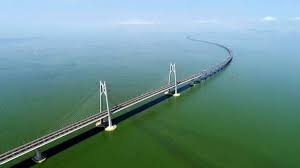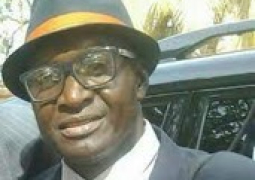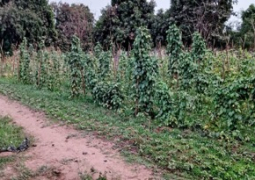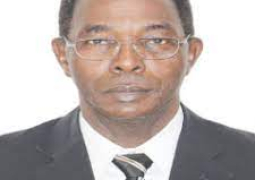
Many of the reviewers deridedthe“exclusivity clauses” in the transacted SGB Agreement, which prohibit the construction of a bridge within a radius of 50 kilometres of the Senegambia crossing, and more controversially, prohibit any alternative routes of transportation which may be in conflict with the recycledSGB.
Courtesy of CBR: Banjul-Barra Bridge Drawing
The critiques predict obstacles for the future development of the country’s transportation sector, including the proposed Banjul Barra Bridge. In fact, a frequent critique of government, Dr. Ousman Gajigo, (reported in the “Voice” Paperof 17 December 2024) noted that the SGBre-cycling Agreement is a loss at national scale, andthat the distressed state of the country’s economy, indicated by the present Debt/GDB ratio, cannot accommodate or sustain the implementation of BBB, especially given its cost, which he said is US$2 billion (no reference provided). Many other critiques in the media echoedsimilar sentiments, except of course Government press releases on the matter.
Meanwhile, all commentson theBanjul Barra Bridge idea seem to portraythat there is no Feasibility Study (FS); that there isneedfor a FS; that thecost of the bridge will be exorbitant andtherefore not affordable by the country,not even in the foreseeable future.
The reason for this Articleis to dispel thesebeliefs, and to note that since 2017there were: (i)a Feasibility Study (FS) of the Banjul Barra Bridge; (ii) a FSof the Banjul Port Expansion, and (iii) FS and Detailed Designs of the URR Road and Bridges projects, all of which were sponsored and financed by the People’s Republic of China (PRC).
As for the FS of the BBB Project, this was initiated in 2013, completed in 2016, and updated in 2017 by China Road and Bridges Company (CRBC), a Chinese Engineering, Procurement and Construction (EPC) company. In the FS, CBRC located the optimal position of the bridge, and determinedthe relevant geological and hydrographic properties of the alignmentwithin the river estuary; they established structural requirements of the bridge, and the cost (between US$ 700 million to US$ 1 billion, depending on the accepted scheme);they forecasted traffic flows in the event of the bridge, and conducted economic, financial, and environmental analysis of the Project;the CBRC study determined positive and acceptable net present value (NPV),internal rate of return (IRR), andpayback period. In other words,since 2017, the BBB Feasibility Study gave definite and positive answers to all pertinent questions of the bridge concerning itsviability and sustainability, which wereof technical, economic, social, and environmental nature.
However, out of the threenoted feasibility studies (by 2017), only one was implemented, the URR Road and Bridges Project, while the other two, viz.: Banjul Barra Bridge and Banjul Expansion Project went up on a tussle, among the so-called customary donors (IMF, WB, EU, AfDB, and Middle Eastern finance institutions) and thePRC, who were more advanced in the conception phases of all the 3 projects.
Nonetheless, around this critical period, the PRC signed with GOTG, on July 2017, theURR Projects Agreement (a grant of US$81 million); the FS was launched 10 December 2017, and Final Design completed in June 2018. The scope of the Project included theBasse Bridge of 250 metres, with a linking road of 2.24 kilometres; Fatoto Bridge of 170 metres, with linking road of 1.77 kilometres; the Road from Basse via Fatoto to Koina of 47 kilometres; and along the road, Chamoi Bridge of 25 metres, Suduwol Bridge of 32 metres, and about 30 culverts of various sizes.
The URR Project works commenced on 15 December 2018, for a duration of 32 months, (i.e. completion date of 15 August 2021). It is remarkable that the URR Projectsidea was conceived, evaluated for feasibility, designed, and constructed in 4 years, compared to the Lamin Koto Passimas Project (of less scope) which took 3 Government regimes,and more than 40 years to be accomplished, under the traditional donor funding, pursued since independence by the country.It is also remarkable to note that the works for the Sir Dawda Jawara International Conference Centre(a US$ 50M grant from the PRC), specially funded to host a Muslim congress, the OIC, was commenced on 14 September 2017 and inaugurated in January of 2020, in barely 3 years.
By way of comparisonbetween thetrajectories of traditional donor and the PRC project financing and implementation, wecannot but recallhow the coalition government of 2017 embarked on a National Development Plan (NDP, 2018 – 2021),a Flagship and Priority Projects & Financing Options, not to mention the Recovery Focused- National Development Plan (RF-NDP 2023 – 2027, “Yiriwa”) updatesof later date, all of which were designed to bring economic and social recovery, initially presented to the Brussels Donor Conference in May of 2018. The Recovery Projects wereestimated to be about US$ 2.4 billion, opened to grants, credits, or loans, presented to the customary multilateral and bilateral donors. For the grant and credit requests(particularly directed to WB and EU), they became subjected to “Country Assistance Strategies”, usually in the form of budget support, but under conditionalities of privatizing public assets, gender equality orgay rights, etc. For loans, the stumbling block became the Debt/GDP ratio, which in 2018 was about 124%. Thecustomary partners not only required that the Debt/GDP ratio was below a certain threshold, but they gauged the lending risks to the country, and therefore augmented the cost or interest of possible loans.The Conference pledged US$ 1.7 billion to assist the new democracy, but it’s anybody’s guess today what really materialized from this pledge. The presented “Priority Projects”were: Electricity Restoration and Modernization Project; • Rural Roads; • Greater Banjul Area roads; • Expansion of Sting Corner to Airport junction; • Banjul Port Expansion; • Basse Inland Port; • River Transport Development and Tourism promotion; • Enhancing ICT Services; • Safe and Affordable water supply-WASH, etc.
By way of similar comparison, we note that the relation between The Gambia and PRC dates back from the 60’s, although diplomatic relation was made official in December of 1974. President Dawda Jawara, between 1975 and 1991, made four state visits to China. The PRC financed and constructed the only National Stadium, and fielded many agriculturists, engineers, and doctors to The Gambia, on consistent basis, until the Jammeh regime, after staging a coup, decided to recognize the Republic of China (ROC or Taiwan) in July of 1995; the PRC as a consequence decided to suspenddiplomatic ties with The Gambia.
However, the Jammeh regime eventually severed ties with ROC (November 2013), and resumeddiplomatic ties with PRC (March 2016). The renewedties with PRC ushered a new phase of relationship, and triggered major projects, one of which was the Banjul Barra Bridge.
For those of uswho had the opportunity to studythe Feasibility Study of the Banjul Barra Bridge Project (2016/17), we cannot let the matter slide into oblivion, given that theProject has considerable impact onregional transportation (at the scale of ECOWAS and AU); it promises to meet the needs of variouscommuters, traders, and transporters, whose numbers are increasing on a yearly basis, and will soon, if not already, reach a crisis stage. At the moment, more than the population of The Gambia (2.5 million) is ferriedevery year at this crossing point, under severe delays, uncertainties, and great perils. The Bridge holds the promise to free this social and economic blockage, and to becomea prodigiousasset for The Gambia, and for the region and beyond.
Bai Lamin Jobe
Cape Point
7 January 2025
Read Other Articles In Opinion
Reflections on the new constitution
Jun 19, 2020, 1:47 PM




